Abstract
Previous studies have indicated that the coagulase-positive Staphylococcus (Staphylococcus aureus) has potential as a useful indicator of the infection hazard associated with the use of swimming pools and other recreational waters. However, before this indicator system can be used effectively, a recovery system that is sufficiently selective, accurate, and reliable for the enumeration of S. aureus must be developed. In this study, Vogel-Johnson (VJ) and Baird-Parker (BP) agars were compared for efficacy in the primary isolation and recovery of S. aureus from swimming pool water. For equal sample volumes of pool water containing adequate free chlorine residual, VJ agar was found to be more selective for staphylococcal species and less inhibitory to general cell growth than was BP agar. However, neither medium was found to be sufficiently differential to permit the accurate identification of S. aureus. In contrast, water samples obtained from a swimming pool containing very low levels of chlorine (none of which was in the free form) showed abundant growth of staphylococci on both test media, with both VJ and BP agars showing increased sensitivity for the detection of S. aureus. Thus, VJ and BP agars show increased sensitivity for the detection of coagulase-positive staphylococci from unchlorinated versus chlorinated waters.
Full text
PDF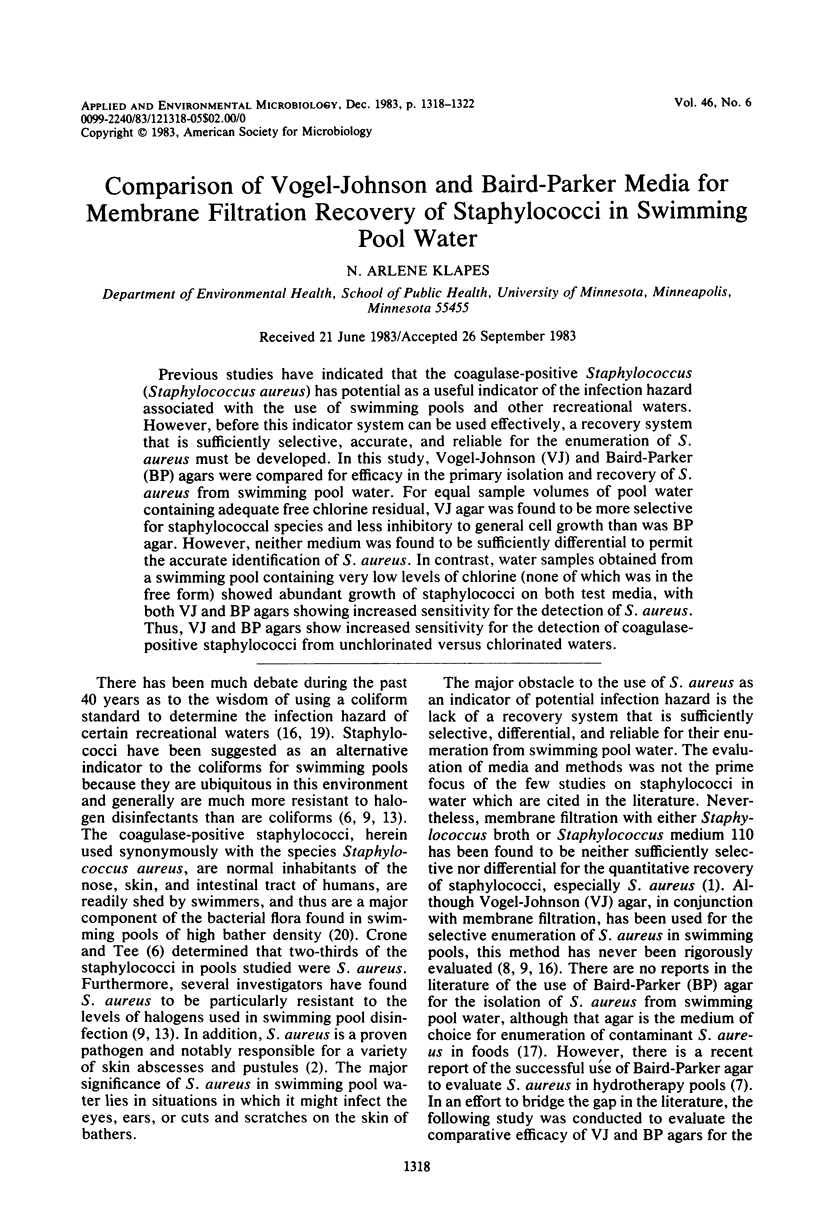
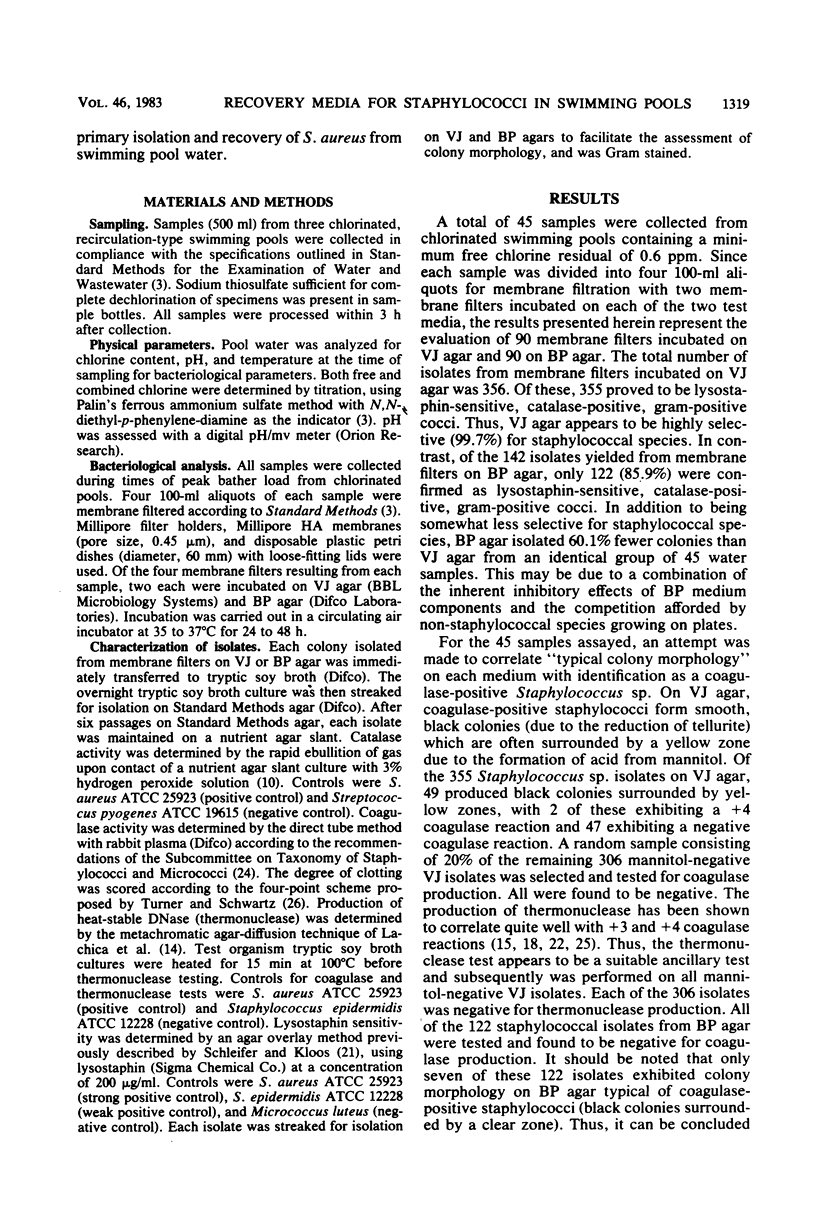
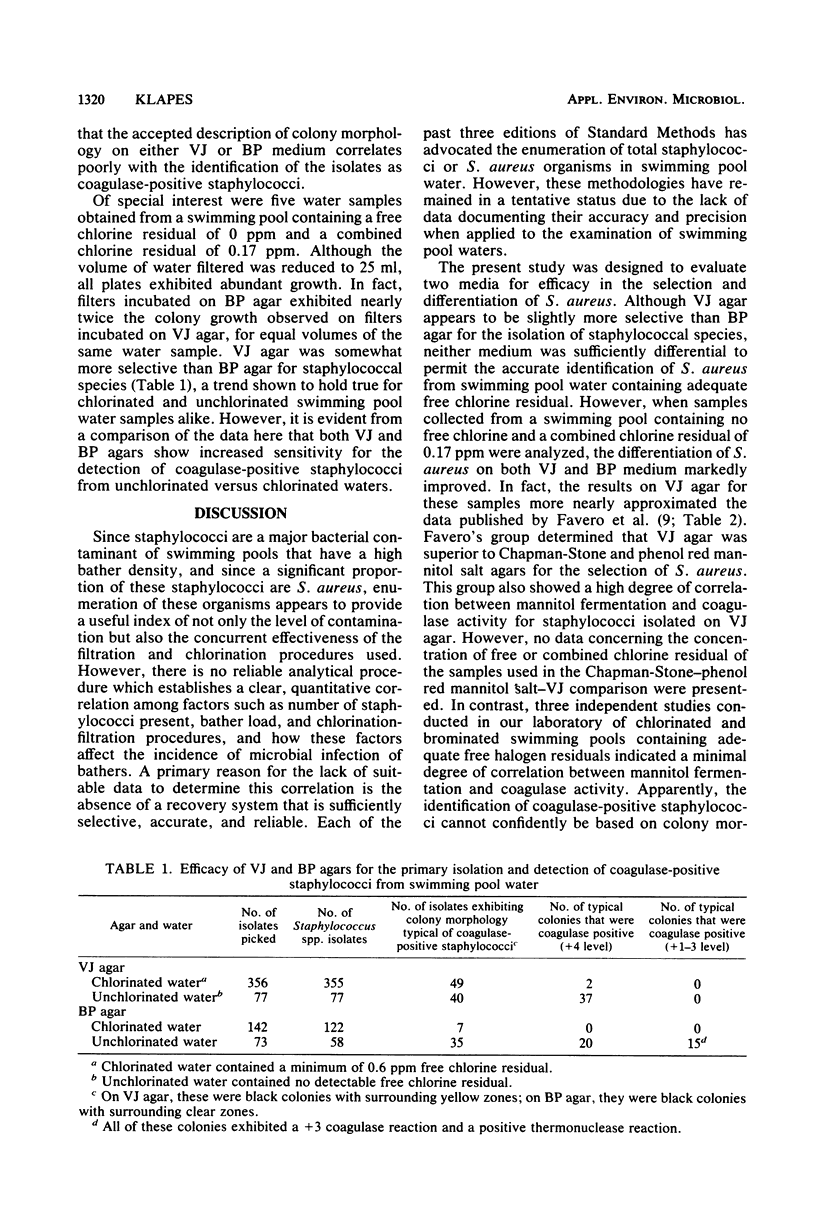
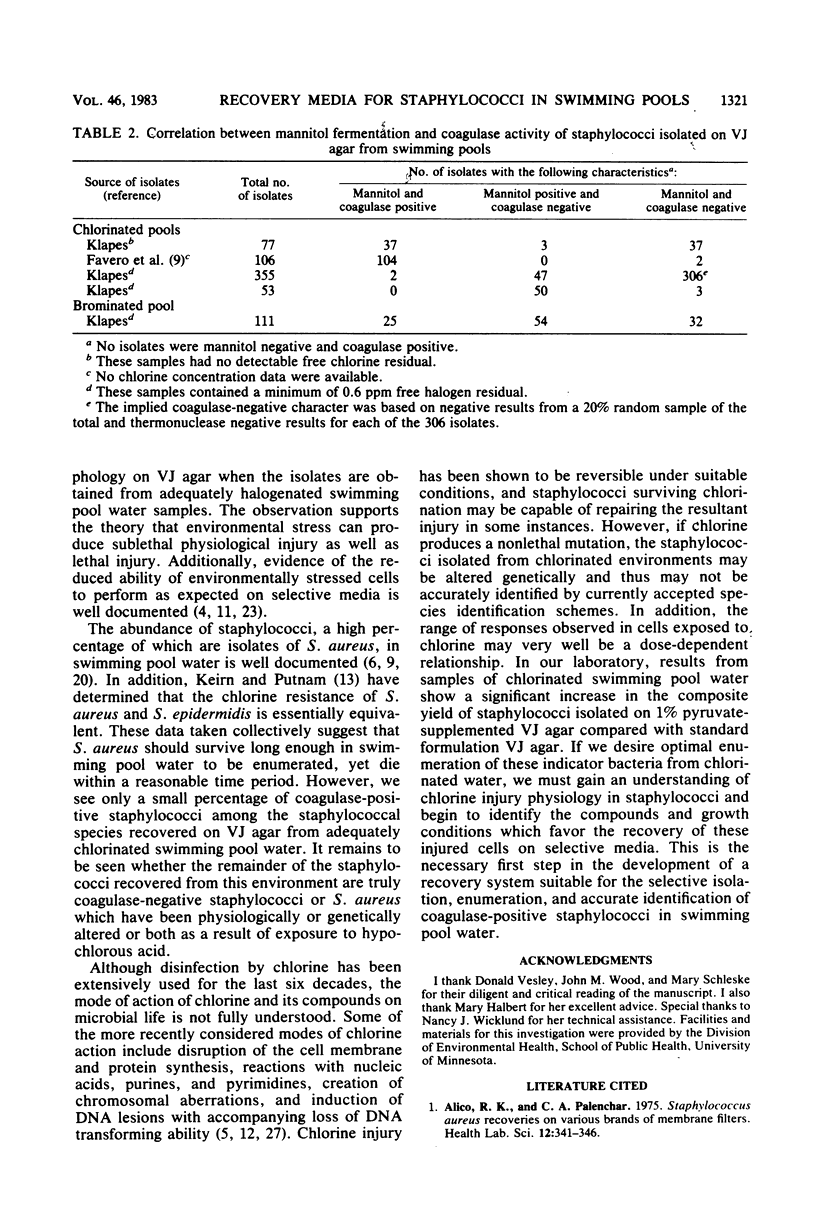
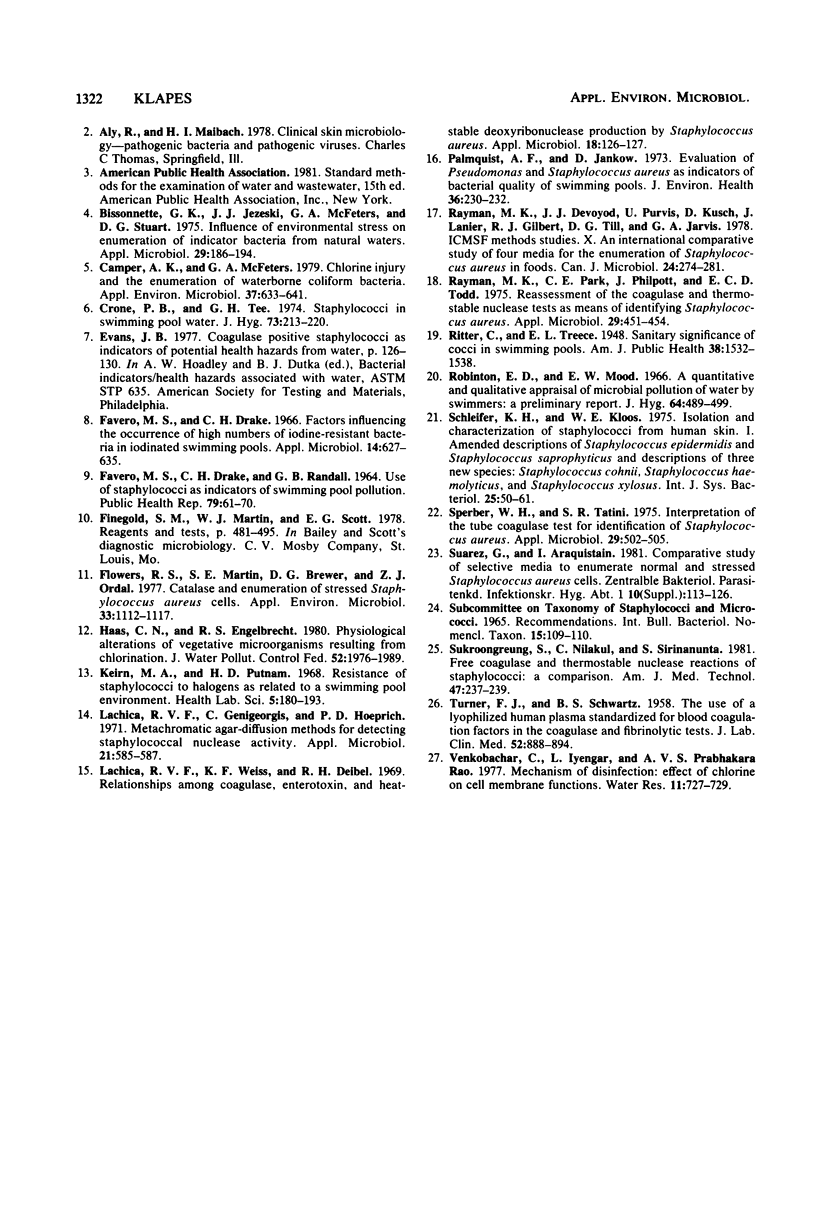
Selected References
These references are in PubMed. This may not be the complete list of references from this article.
- Alico R. K., Palenchar C. A. Staphylococcus aureus recoveries on various brands of membrane filters. Health Lab Sci. 1975 Oct;12(4):341–346. [PubMed] [Google Scholar]
- Bissonnette G. K., Jezeski J. J., McFeters G. A., Stuart D. G. Influence of environmental stress on enumeration of indicator bacteria from natural waters. Appl Microbiol. 1975 Feb;29(2):186–194. doi: 10.1128/am.29.2.186-194.1975. [DOI] [PMC free article] [PubMed] [Google Scholar]
- Camper A. K., McFeters G. A. Chlorine injury and the enumeration of waterborne coliform bacteria. Appl Environ Microbiol. 1979 Mar;37(3):633–641. doi: 10.1128/aem.37.3.633-641.1979. [DOI] [PMC free article] [PubMed] [Google Scholar]
- Crone P. B., Tee G. H. Staphylococci in swimming pool water. J Hyg (Lond) 1974 Oct;73(2):213–220. doi: 10.1017/s0022172400024049. [DOI] [PMC free article] [PubMed] [Google Scholar]
- FAVERO M. S., DRAKE C. H., RANDALL G. B. USE OF STAPHYLOCOCCI AS INDICATORS OF SWIMMING POOL POLLUTION. Public Health Rep. 1964 Jan;79:61–70. [PMC free article] [PubMed] [Google Scholar]
- Favero M. S., Drake C. H. Factors influencing the occurrence of high numbers of iodine-resistant bacteria in iodinated swimming pools. Appl Microbiol. 1966 Jul;14(4):627–635. doi: 10.1128/am.14.4.627-635.1966. [DOI] [PMC free article] [PubMed] [Google Scholar]
- Flowers R. S., Martin S. E., Brewer D. G., Ordal Z. J. Catalase and enumeration of stressed Staphylococcus aureus cells. Appl Environ Microbiol. 1977 May;33(5):1112–1117. doi: 10.1128/aem.33.5.1112-1117.1977. [DOI] [PMC free article] [PubMed] [Google Scholar]
- Haas C. N., Engelbrecht R. S. Physiological alterations of vegetative microorganisms resulting form chlorination. J Water Pollut Control Fed. 1980 Jul;52(7):1976–1989. [PubMed] [Google Scholar]
- Keirn M. A., Putnam H. D. Resistance of staphylococci to halogens as related to a swimming pool environment. Health Lab Sci. 1968 Jul;5(3):180–193. [PubMed] [Google Scholar]
- Lachica R. V., Genigeorgis C., Hoeprich P. D. Metachromatic agar-diffusion methods for detecting staphylococcal nuclease activity. Appl Microbiol. 1971 Apr;21(4):585–587. doi: 10.1128/am.21.4.585-587.1971. [DOI] [PMC free article] [PubMed] [Google Scholar]
- RITTER C., TREECE E. L. Sanitary significance of cocci in swimming pools. Am J Public Health Nations Health. 1948 Nov;38(11):1532–1538. doi: 10.2105/ajph.38.11.1532. [DOI] [PMC free article] [PubMed] [Google Scholar]
- Rayman M. K., Devoyod J. J., Purvis U., Kusch D., Lanier J., Gilbert R. J., Till D. G., Jarvis G. A. ICMSF methods studies. X. An international comparative study of four media for the enumeration of Staphylococcus aureus in foods. Can J Microbiol. 1978 Mar;24(3):274–281. doi: 10.1139/m78-047. [DOI] [PubMed] [Google Scholar]
- Rayman M. K., Park C. E., Philpott J., Todd E. C. Reassessment of the coagulase and thermostable nuclease tests as means of identifying Staphylococcus aureus. Appl Microbiol. 1975 Apr;29(4):451–454. doi: 10.1128/am.29.4.451-454.1975. [DOI] [PMC free article] [PubMed] [Google Scholar]
- Robinton E. D., Mood E. W. A quantitative and qualitative appraisal of microbial pollution of water by swimmers: a preliminary report. J Hyg (Lond) 1966 Dec;64(4):489–499. doi: 10.1017/s0022172400040808. [DOI] [PMC free article] [PubMed] [Google Scholar]
- Sperber W. H., Tatini S. R. Interpretation of the tube coagulase test for identification of Staphylococcus aureus. Appl Microbiol. 1975 Apr;29(4):502–505. doi: 10.1128/am.29.4.502-505.1975. [DOI] [PMC free article] [PubMed] [Google Scholar]
- Sukroongreung S., Nilakul C., Sirinanunta S. Free coagulase and thermostable nuclease reactions of staphylococci: a comparison. Am J Med Technol. 1981 Apr;47(4):237–239. [PubMed] [Google Scholar]
- TURNER F. J., SCHWARTZ B. S. The use of a lyophilized human plasma standardized for blood coagulation factors in the coagulase and fibrinolytic tests. J Lab Clin Med. 1958 Dec;52(6):888–894. [PubMed] [Google Scholar]
- Victor R., Lachica F., Weiss K. F., Deibel R. H. Relationships among coagulase, enterotoxin, and heat-stable deoxyribonuclease production by Staphylococcus aureus. Appl Microbiol. 1969 Jul;18(1):126–127. doi: 10.1128/am.18.1.126-127.1969. [DOI] [PMC free article] [PubMed] [Google Scholar]


